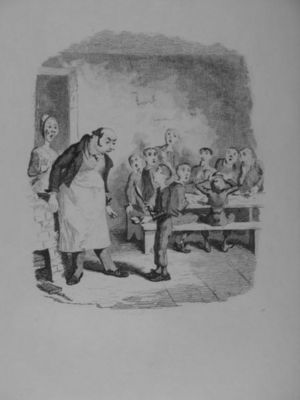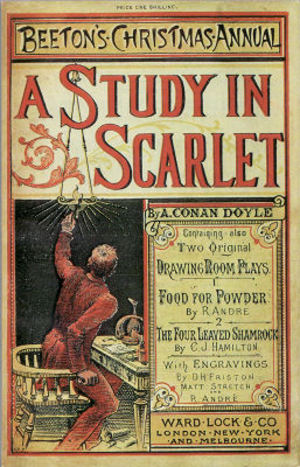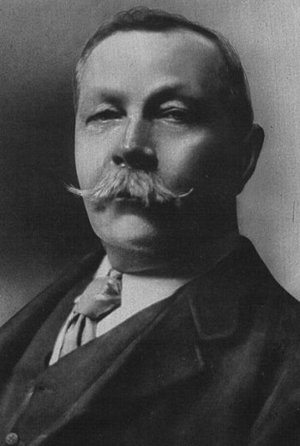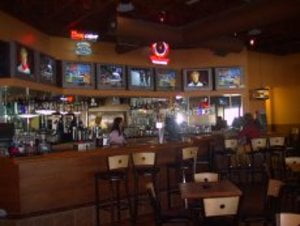Charles Dickens has been labeled both a master of characterization and a writer who creates caricatures meant to embody certain generic assumptions rather a writer capable of creating fully fleshed-out human beings. Regardless of which side of that fence a reader may find themselves standing, few would argue that Dickens’ novels have been a primary contributor to the way that most people view Victorian England. Between Arthur Conan Doyle’s stories of Sherlock Holmes pursing criminals through the back alleys of London and Dickens’ stories of poor orphans struggling to survive, the image of Victorian England that is perhaps forever burned into the public consciousness is one of filth and unfairness. Considering that the period was one of massive turmoil created as a result of the industrial revolution, no doubt this image is hardly far off the mark. Great Expectations is a novel that sets to create a social critique of the Victorian era and how the patented unfairness of the social order created a system that served merely to reproduce itself.
Charles Dickens’ may be guilty of creating caricatures more so than the three-dimensional characters of contemporaries such as Dostoyevsky or Flaubert, but that isn’t to suggest that his characterizations don’t serve a valuable of purpose. Whereas the great Russian writer was far more interested in the introspection of his characters as they related to his own philosophical struggles, and whereas Flaubert was more concerned with digging into the psychology of his characters, Dickens used characterisation as means to advance certain social ideas. What Dickens is interested in by the story he tells in Great Expectations isn’t the psychological drive behind Pip’s life, but rather the grand panorama which envelops not only Pip, but indeed all the characters.
Characterization becomes, then, the key to understanding what kind of social critique Dickens was forming. The fanciful names that Dickens typically gave to his characters are often used as ammunition by those critics who say his characterizations are shallow. Indeed, many of the more outrageous names to be found not only in this novel but in the rest of Dickens’ canon would seem egregiously out of place among other realistic novels, but they are there to serve Dickens’ purpose. Miss Haversham, for instance, is ultimately revealed to be living a life that is a complete sham. What better name for a greedy group of people than the Pockets? It is anything but coincidental that Dickens provides names for characters that match their personality. The caricature has always been shorthand, whether in art or literature. Dickens is far less interested in creating realistically named characters that in using characterizations as a means for furthering his social critique.
Characterization for Dickens is on equal par with theme and as such he takes great pains to write characters that reflect their setting, their social condition, their family background. The very language they use is an indication of their social status, but also more. The use of words is very precise in Great Expectations. Consider the constant repetitions of references to legal matters that dot Wemmick’s speeches. At the office Wemmick is seen to be bureaucratic and uncreative and his use of jargon even when speaking of personal matters stands as a glimpse not only into his own personal psyche but also as the kind of devaluation and dehumanization that Dickens is speaking out against. Contrast Wemmick’s speech to that of Joe. Joe’s language is vitally important to understanding the social critique that Dickens is working toward. Before Pip achieves wealth, he is a great admirer of Joe and can overlook his uneducated speech patterns filled with contractions and words that run together. That same language comes to be seen in counterpoint once Pip achieves his riches and begins to see Joe in a new light. He becomes ashamed of him and that shame is foremost represented by Joe’s backward language.
It is not just speech patterns and language development that serves to turn characters themselves into larger critiques of the time. Dickens also uses setting in relation to his characters to define them against the milieu of the story. Setting is always an important component in any story, of course, but Dickens actually employs setting almost as a means of drawing out the deeper mysteries of his characterisation in order to more fully define how his characters relate to his social concerns. To take one of the more obvious examples in Great Expectations, observe how Dickens employs the symbolism of prison specific to characters. Most all the characters in this novel can be said to inhabit a spiritual prison of one sort or another; they may be trying to escape or they may be fully comfortable in the security. A concrete reference to the importance of prison is that Jaggers works near the notorious Newgate. Newgate obviously has great meaning not only to Dickens but to British history and the theme of criminality runs rampant through this and other of his novels. The prison motif applies to Jaggers not because he is a criminal, nor even because he is a lawyer, but rather that he represents the line that separates crime and the law. It is certainly no accident that Jaggers is at the center of the connections that most of the other characters make in the novel. The most obvious symbolic example of this prison motif would naturally be poor Miss Havisham. She is selfish and spoiled and makes a prison for herself. But other characters live under the shadow of the prison motif as well, including Mrs. Joe who has made an emotional prison for herself by virtually damning herself into a life where emotional attachments are impossible.
Perhaps the most impressive use of characterization as a tool for social critique is in the evolution of Pip himself. Whatever criticism may be made about the lack of depth in the characterization of others in the novel, there is no denying that the trajectory and transformation of Pip serves to underscore the critique of social issues and values. What Dickens seems to be driving at isn’t really so much a condemnation of the acquisition of wealth; it would be a mistake to read this as a socialist critique of encroaching capitalism on British society. Clearly, there are many wealthy individuals in the novel who come off quite well and escape Dickens’ searing indictment. Ultimately, the primary thematic concern with wealth that Dickens has is with one’s unhealthy preoccupation with it and inability to understand how having wealth can not only make an individual better, but society as well. The character of Pip is surrounded by minor and supporting players who exemplify this concern and his story in the end becomes that mirrors those concerns.
For instance, Pip is happy with Joe before Pip acquires wealth, whereas Mrs. Joe is thoroughly unhappy with Joe because, unlike Pip, she doesn’t have the necessary moral foundation within her to see that Joe is a good person whether speaks well and has money or not. Mrs. Joe views her husband through a prism of a preoccupation with his failures, much as Pip will eventually come to see him. On the other hand, Pip manages to avoid the failures of Miss Havisham whose preoccupation with her wealth is dependent upon the satisfaction she derives of keeping it to herself. Havisham’s joy is not in the spending of money, but rather in her ability to keep others from spending it. Pip manages to bypass this obstacle, but by going completely in the opposition direction and spending money wildly and foolishly he too ends up suffering as a result of an unhealthy preoccupation.
Dickens uses characterization to express his theme that it isn’t money that corrupts a person, but rather that by allowing one’s moral dispensations to become corrupted by the acquisition of wealth one loses their God-given sense of virtue. It is virtue above all else that Dickens is extolling. Consider that both Joe and Jaggers can be viewed as honorable men, despite their quite obvious differences. Joe is gentlemanly, kind, and honest; Jaggers is calculating and cynical, but nonetheless to be admired. They don’t exactly stand at opposite poles to each other, but the contrasts are striking enough that the similarity becomes more striking as well. Joe is poor, Jaggers a successful lawyer, and neither have allowed their virtue to be corrupted. Pip’s lesson at the end is that he too comes to understand what Joe and Jaggers understand.
The great lesson of Great Expectations is that characterization can actually serve to enhance the theme of a novel. True, many of the characters are less than three-dimensional-some aren’t even two-dimensional-but whereas they could be a fatal flaw in a book more dedicated to the idea of realism as simply an imitation of the real world, Dickens’ mode of realism is to present a critique of the social values at work in his era. That critique is greatly enabled by Dickens’ almost unique ability to turn characters into living, breathing representations of all those ideals he both espouses and abhors.






